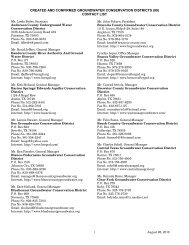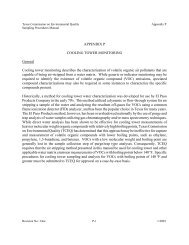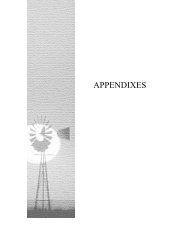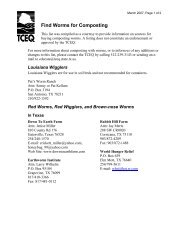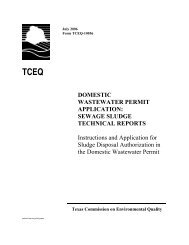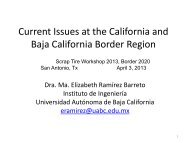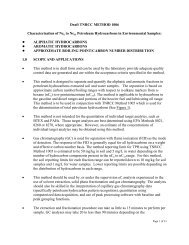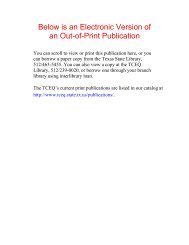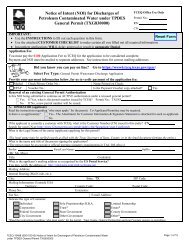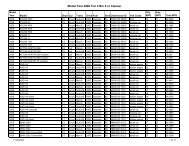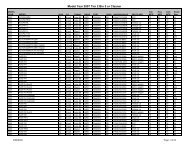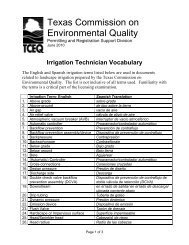Vinyl Chloride - Texas Commission on Environmental Quality
Vinyl Chloride - Texas Commission on Environmental Quality
Vinyl Chloride - Texas Commission on Environmental Quality
Create successful ePaper yourself
Turn your PDF publications into a flip-book with our unique Google optimized e-Paper software.
<str<strong>on</strong>g>Vinyl</str<strong>on</strong>g> chloride<br />
Page 20<br />
The Sim<strong>on</strong>ato et al. (1991) study was updated in Ward et al. (2001) which was not available at the time of<br />
the USEPA (2000) assessment. Because the Ward et al. (2001) study did not reduce the uncertainty<br />
regarding exposure c<strong>on</strong>centrati<strong>on</strong>s and durati<strong>on</strong> of exposure for the original Sim<strong>on</strong>ato et al. (1991) study,<br />
the TD adopted the USEPA (2000) cancer risk estimate based <strong>on</strong> animal data discussed in Secti<strong>on</strong> 4.2.4.2.<br />
Table 7. Risk Estimates for Angiosarcoma based <strong>on</strong> Epidemiological Studies (USEPA 2000)<br />
3 a<br />
Study 95% UCL risk per µg/m<br />
Fox and Collier (1977) 0.46 to 2.8 x 10 -6<br />
J<strong>on</strong>es et al. (1988) b -6 c<br />
0.65 to 2.4 x 10<br />
Sim<strong>on</strong>ato et al. (1991) 0.27 to 0.53 x 10 -6<br />
a<br />
Risk estimates based <strong>on</strong> RISK dose metric<br />
b<br />
J<strong>on</strong>es et al. (1988) was an update of Fox and Collier (1977).<br />
c<br />
Highest value in range reported by USEPA (2000) as the best risk estimate from human studies.<br />
4.2.4.1.2 Clewell et al. (2001)<br />
Clewell et al. (2001) developed a PBPK model for VC which was described in Secti<strong>on</strong> 4.2.4.1.2 and<br />
applied this PBPK model with slight modificati<strong>on</strong>s in some parameters to develop human risk estimates<br />
for angiosarcoma based <strong>on</strong> human epidemiological studies (Table 8) and animal studies (Secti<strong>on</strong><br />
4.2.4.2.2). Risk estimates developed for angiosarcoma based <strong>on</strong> the RISK dose metric from the Fox and<br />
Collier (1977), J<strong>on</strong>es et al. (1988), and Sim<strong>on</strong>ato et al. (1991) studies are presented in Table 8. Risk<br />
estimates obtained from all three dose metrics were reportedly very similar but <strong>on</strong>ly those based <strong>on</strong> the<br />
RISK dose metric were presented in the study. The lower risk estimate in each range was calculated using<br />
the background probability of liver cancer death derived in the study while the higher risk estimate was<br />
calculated using an estimate of lifetime liver cancer mortality rate in the US populati<strong>on</strong> from Chen and<br />
Blancato (1989).<br />
Table 8. Risk Estimates for Angiosarcoma based <strong>on</strong> Epidemiological Studies (Clewell et al.<br />
2001).<br />
Study<br />
3 a<br />
95% UCL risk per µg/m<br />
Fox and Collier (1977) 0.27 to 1.6 x 10 -6<br />
J<strong>on</strong>es et al. (1988) b 0.37 to 1.38 x 10 -6<br />
Sim<strong>on</strong>ato et al. (1991) 0.15 to 0.30 x 10 -6<br />
a<br />
Risk estimates based <strong>on</strong> RISK dose metric<br />
b<br />
J<strong>on</strong>es et al. (1988) was an update of Fox and Collier (1977) .<br />
4.2.4.2 Dose Metrics and Potency Estimates Based <strong>on</strong> Animal Data<br />
4.2.4.2.1 USEPA (2000)<br />
USEPA (2000) applied the PBPK model for VC developed by Clewell et al. (1995a) to calculate human<br />
risk estimates from animal data. Human risk estimates were calculated based <strong>on</strong> this PBPK model and the



